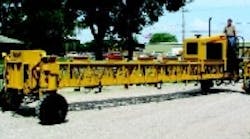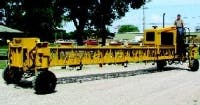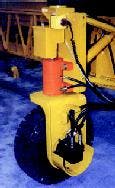For the average motorist, encountering a newly paved road is like a little bit of nirvana. But achieving that smooth new finish is a constant challenge for road building crews. When paving a road, contractors often have to meet specifications on the smoothness of the road. This is often referred to as the ride or rideability. If the road is too bumpy, the contractor may have to pay to have the concrete surface ground. In the past, the contractor could put down a mile of pavement and would have to wait until the next day to run a contact type profile machine to get the smoothness results.
GOMACO, Ida Grove, Iowa, manufacturers the GSI smoothness indicator, which provides the contractor immediate feedback on the smoothness, allowing them to make adjustments to the paving process accordingly. The GSI rides on a vehicle that looks a bit like a stretched version of a tractor. A long frame connects the two ends of the vehicle, which is designed to straddle a newly paved road and move sideways, along the road's length. All four wheels ride along the berm, allowing non-contact sensors along the truss to measure the smoothness of the paved surface while the concrete is still in a plastic condition. This also gives the paving contractor the opportunity to make changes to the surface before the concrete is cured.
Each wheel is attached to a Model L20-25 hydraulic rotary actuator from Helac Corp., Enumclaw, Wash., allowing all four wheels to turn up to 180° — essentially giving the vehicle crab steering capability. According to Jeff Johnson, senior R&D engineer for GOMACO, "We have similar machines that follow behind the paver with open-loop propel systems, that skid-steer only. While they are cost effective, they can be more challenging to maneuver around the job site. We wanted a machine that could be moved from location to location easily. The solution was to use a dualpath, closed-loop travel system, in conjunction with rotary actuators to turn the wheels. This gave us a wide speed range and the ability to turn the wheels to drive the machine lengthwise."
The foot mounting configuration with through-drilled holes enables the actuators to be bolt mounted to the frame of the vehicle. The wheel yoke is bolt mounted directly to the output shaft's integral, large diameter drilled and tapped flange. The L20 Series is a helical hydraulic rotary actuator that uses a sliding helical gear operating concept ,which converts linear piston motion into powerful shaft rotation as well as provides exceptional resilience to shock loading. The high helix angles of the internal gearing results in compact configurations and high output torque. The actuator features integral bearings that support the vehicle without the need for additional external bearings.
Hydraulics provides the vehicle's propulsion, too. The basic propel system consists of a left closed-loop pump, right closed-loop pump, four motors, steering wheel, joystick, and digital control system. hydraulics turn the wheels. Wheels are bolted to Fairfield torque-hubs (planetary gear reducers). The torque-hubs bolt to the yokes that are connected to the rotary actuators. Hydraulic motors connect directly to the torque-hubs.
Having left and right pumps lets the control system vary the wheel speeds during turns and allows the machine to counter-rotate. This system gives a wide operating speed range from 10 fpm to 4 mph.
The operator controls the travel speed and direction using a joystick, and turns via a steering wheel. If a stringline has been set for guiding a paver, stringline sensors can be used to steer the machine automatically.



